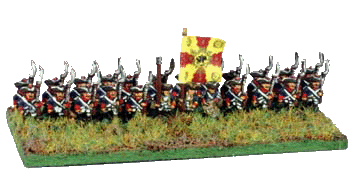THE SEVEN YEARS WAR
In 1755, when hostilities broke out in North America, George II, king
of England and elector of Hanover, negotiated the Treaty of Westminster
with Frederick II of Prussia, who guaranteed the neutrality of Hanover.
This event hastened the alliance (1756) of France and Austria, sometimes
called the “diplomatic revolution.” Shortly afterward Frederick
II opened hostilities by invading Saxony. In Jan., 1757, war was declared
on the aggressor in the name of the Holy Roman Empire. Austria concluded
alliances with France and Russia and was joined by Sweden. The main European
phase of the war began with the Prussian invasion of Bohemia early in
1757.
The struggle was complex in its origin and involved two main distinct
conflicts—the colonial rivalry between France and England and the
struggle for supremacy in Germany between the house of Austria and the
rising kingdom of Prussia. It was preluded in America by the outbreak
of the last of the French and Indian Wars and in India by fighting among
native factions and the struggle there between the French governor Dupleix
and the British statesman Robert Clive .
The War of the Austrian Succession (1740-48) had left Austria humiliated.
Seeking to recover Silesia from Prussia, Empress Maria Theresa even before
the conclusion of that war had secured the alliance of Elizabeth of Russia.
In the years following the Treaty of Aix-la-Chapelle (1748), Kaunitz ,
as Austrian ambassador to France and then as chancellor, worked for a
rapprochement with France.
Victorious at first, Frederick was severely defeated by the Austrians
under Daun at Kolin (June, 1757) and had to evacuate Bohemia. The fighting
was carried into Saxony and Silesia, where Frederick gained the great
victories of Rossbach (Nov., 1757) and Leuthen (Dec., 1757) over the French
and Austrians. The Russians, who had invaded Prussia, were defeated by
Frederick at Zorndorf (Aug., 1758). The English and Hanoverians, at first
unsuccessful against the French in NW Germany, began a vigorous effort
when William Pitt (later earl of Chatham ) came into power; the troops
then won the victories of Krefeld (June, 1758) and Minden (Aug., 1759).
However, Frederick soon found himself in an almost desperate situation.
He was badly beaten by Daun at Kunersdorf (Aug., 1759) and in Nov., 1759,
Daun captured a Prussian army of 13,000 at Maxen. In Oct., 1760, the Russians
took Berlin. Days later, as Frederick's army approached, they evacuated
it, and in November Frederick defeated Daun at Torgau. Nonetheless, his
situation remained critical, especially after the fall of Pitt (1761)
deprived him of British subsidies. The death (Jan., 1762) of Elizabeth
of Russia and the accession of Peter III , Frederick's ardent admirer,
helped save him from defeat.
By the Treaty of St. Petersburg (1762) Russia made peace and restored
all conquests; Sweden made peace in the same year. Now fighting alone
in the east, the Austrians were soundly defeated at Burkersdorf (July,
1762). The French, too, had suffered severe reverses. In America they
had lost Louisburg (1758), Quebec (1759), and some possessions in the
West Indies; in India, the British victories at Plassey (1757) and Pondichéry
(1761) had destroyed French power; on the sea, the French took Port Mahón
from the British (1757) but were defeated by Hawke in Quiberon Bay (1759).
The entry of Spain into the war under the terms of the Family Compact
of 1761 was of little help to France, where the war had never been popular.
After protracted negotiations between the war-weary powers, peace was
made (Feb., 1763) among Prussia, Austria, and Saxony at Hubertusburg ,
and among England, France, and Spain at Paris (see Paris, Treaty of ,
1763). The treaty of Hubertusburg, though it restored the prewar status
quo, marked the ascendancy of Prussia as a leading European power. Through
the Treaty of Paris, Great Britain emerged as the world's chief colonial
empire, which was its primary goal in the war, and France lost most of
its overseas possessions. For Russia the Seven Years War was the first
great venture into purely European affairs.
Figure Format
Line infantry and Grenadiers are based four figures to a strip, facing
forward, on a 20mm frontage. Light Infantry (four to a strip), and Mounted
troops (three to a strip), are based in file for cutting and rebasing.
Foot Command strips, (Soldier Officer, Ensign and Drummer) are included
in all Line Infantry packs at a rate of four strips of command to twenty
of line. I can vary this proportion on request. Mounted Command strips
(Trooper, Trumpeter and Officer) are included in all packs at a rate of
five strips of command to ten of line. I can vary this proportion on request.
VAT
Value Added Tax at 20% must be charged on all goods sold within the EU.
Non-EU residents are not eligible for this tax and wil be charged at the
non-VAT total.




